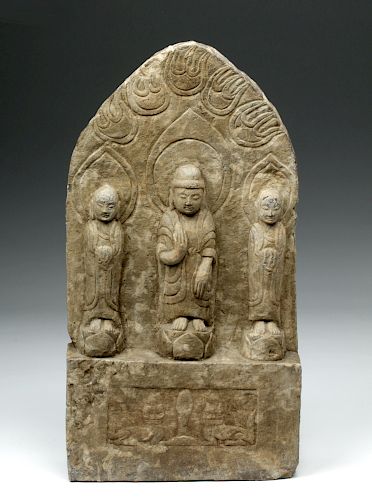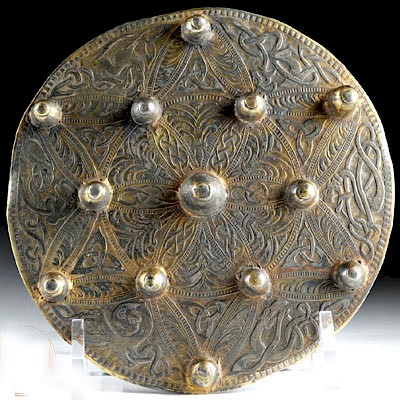Chinese Ming Dynasty Stone Panel w/ Buddha
Lot 82a
About Seller
Artemis Gallery
686 S Taylor Ave, Ste 106
Louisville, CO 80027
United States
Selling antiquities, ancient and ethnographic art online since 1993, Artemis Gallery specializes in Classical Antiquities (Egyptian, Greek, Roman, Near Eastern), Asian, Pre-Columbian, African / Tribal / Oceanographic art. Our extensive inventory includes pottery, stone, metal, wood, glass and textil...Read more
Estimate:
$3,500 - $5,000
Absentee vs Live bid
Two ways to bid:
- Leave a max absentee bid and the platform will bid on your behalf up to your maximum bid during the live auction.
- Bid live during the auction and your bids will be submitted real-time to the auctioneer.
Bid Increments
| Price | Bid Increment |
|---|---|
| $0 | $25 |
| $300 | $50 |
| $1,000 | $100 |
| $2,000 | $250 |
| $5,000 | $500 |
| $10,000 | $1,000 |
| $20,000 | $2,500 |
| $50,000 | $5,000 |
| $100,000 | $10,000 |
| $200,000 | $20,000 |
About Auction
By Artemis Gallery
Jul 19, 2018
Set Reminder
2018-07-19 10:00:00
2018-07-19 10:00:00
America/New_York
Bidsquare
Bidsquare : Fine Antiquities/Ethnographic Art
https://www.bidsquare.com/auctions/artemis-gallery/fine-antiquities-ethnographic-art-3329
Featuring classical antiquities, ancient and ethnographic art from cultures encompassing the globe, plus fine art. Artemis Gallery info@artemisgallery.com
Featuring classical antiquities, ancient and ethnographic art from cultures encompassing the globe, plus fine art. Artemis Gallery info@artemisgallery.com
- Lot Description
East Asia, China, Ming Dynasty, ca. 1368 to 1644 CE. A gorgeous carved stone panel depicting a standing Buddha flanked by two attendants (probably bodhisattvas). The Buddha stands in the Abhaya-vara mudra, with one hand raised, palm out, and the other facing downward, palm out. This is the gesture of fearlessness, representing protection, peace, and dispelling fear. The Buddha and his attendants are all standing on round, lotus-shaped pedestals against a curved, stupa-like background. Below their pedestals is a slightly raised platform, its face decorated with relief imagery of two fu-dog style chimera animals flanking a round symbol that might be a mirror. Size: 10" W x 19.1" H (25.4 cm x 48.5 cm)
This panel was most likely an architectural feature, placed in the wall of a temple. During the Ming Dynasty, Buddhism flourished, despite imperial edicts controlling it and constant criticism from Confucian officials. People from all segments of Ming society, including ethnic Chinese and non-Chinese people and elites and non-elites, were enthusiastic practitioners. Some of the Ming emperors even gave official patronage to the religion, and Buddhist monasteries and monks had tremendous power.
Provenance: private Stockton, New Jersey, USA collection
All items legal to buy/sell under U.S. Statute covering cultural patrimony Code 2600, CHAPTER 14, and are guaranteed to be as described or your money back.
A Certificate of Authenticity will accompany all winning bids.
We ship worldwide and handle all shipping in-house for your convenience.
#129267Small losses to edges and one larger loss to the upper left (facing) of the lower panel. Surface scratching and smoothing commensurate with age. Very nice remaining details of the figures, with a patina from age and handling.Condition
- Shipping Info
-
All shipping is handled in-house for your convenience. Your invoice from Artemis Gallery will include shipping calculation instructions. If in doubt, please inquire BEFORE bidding for estimated shipping costs for individual items.
-
- Buyer's Premium



 EUR
EUR CAD
CAD AUD
AUD GBP
GBP MXN
MXN HKD
HKD CNY
CNY MYR
MYR SEK
SEK SGD
SGD CHF
CHF THB
THB
















